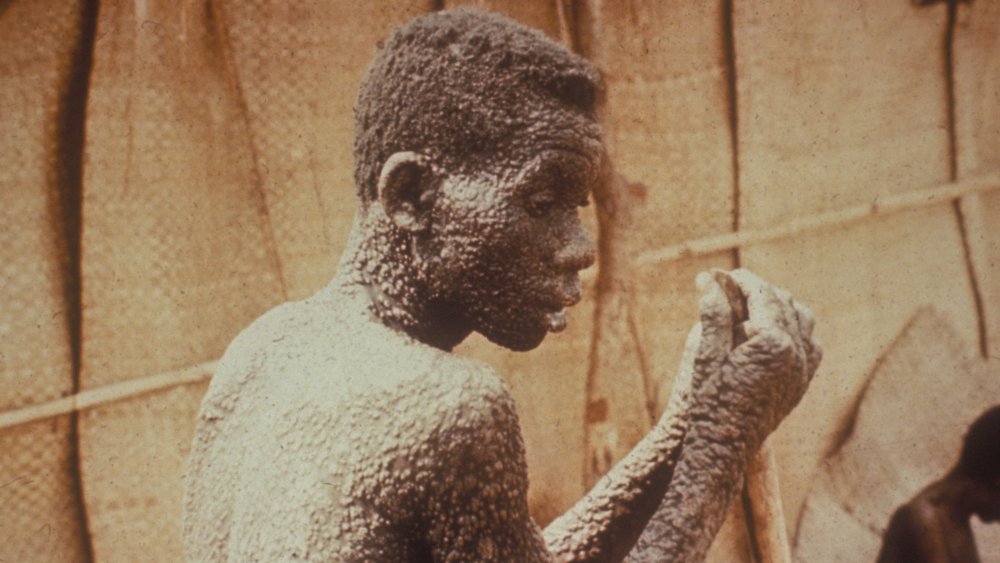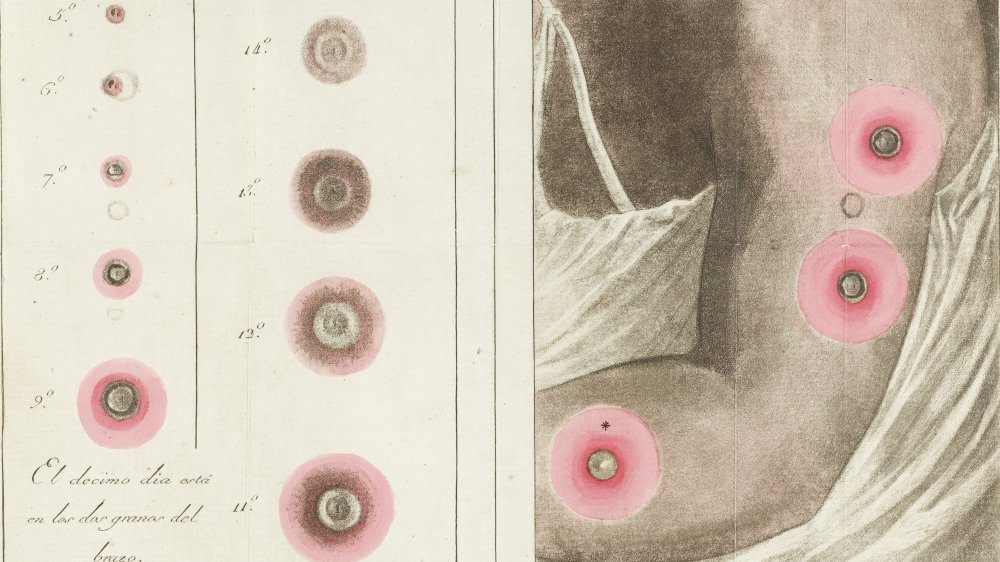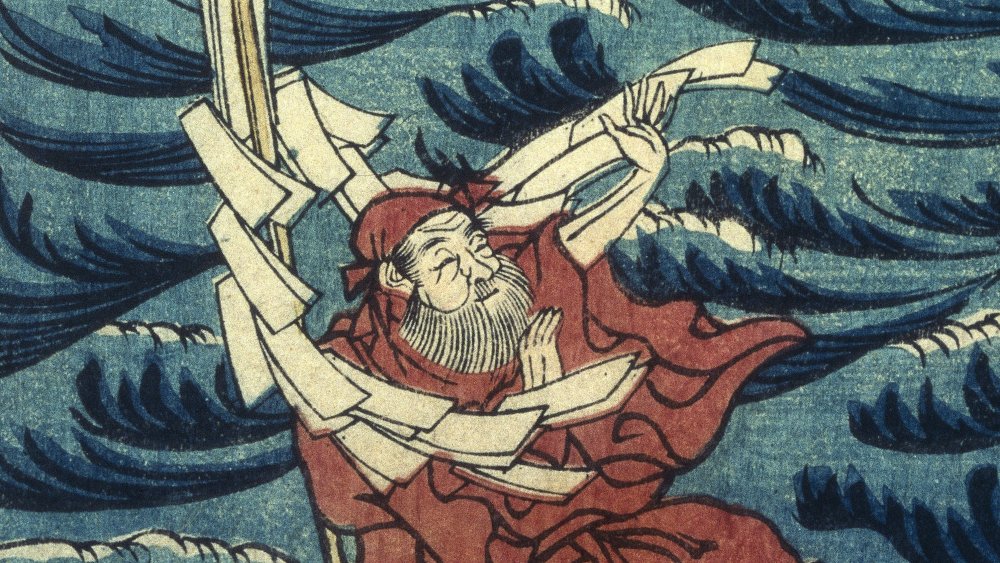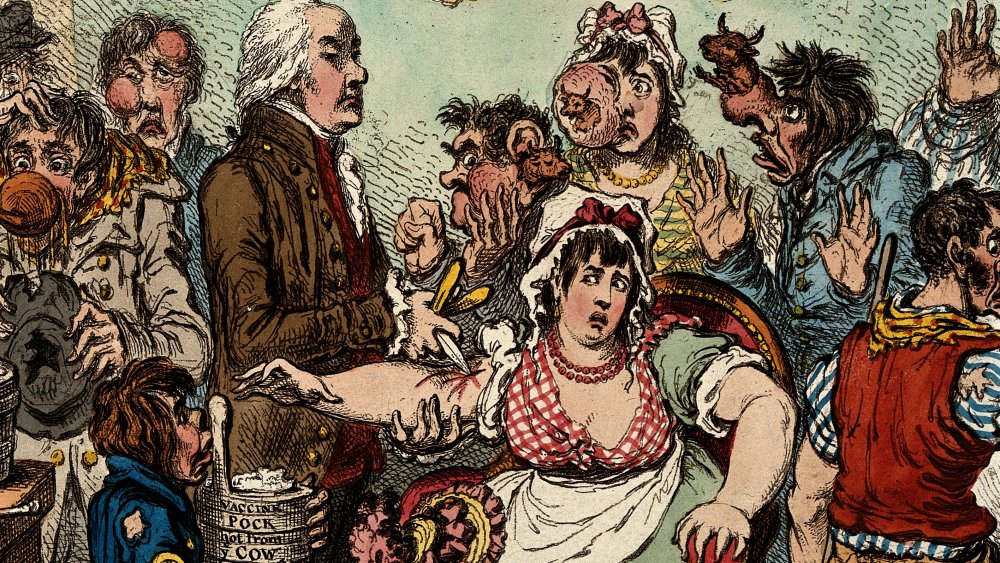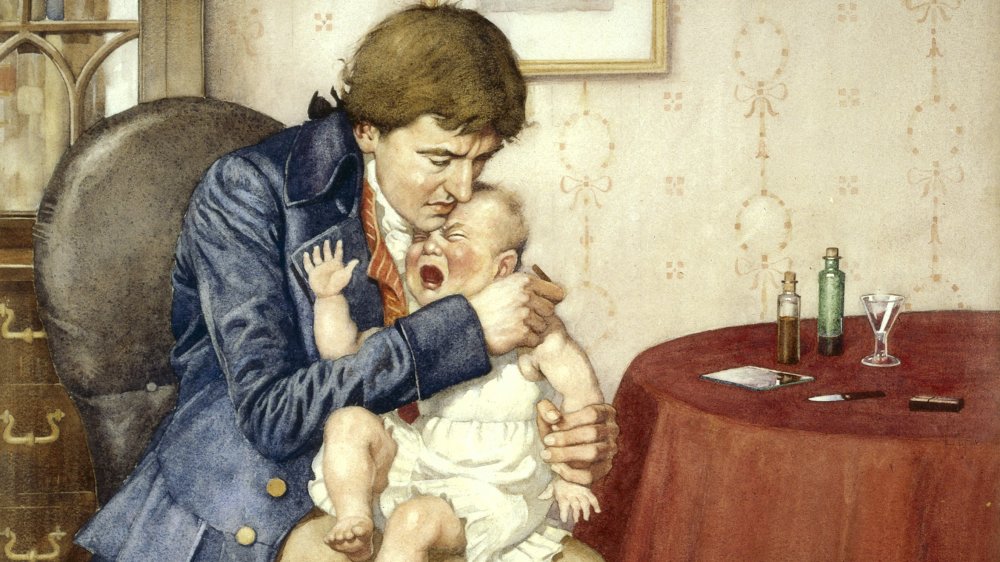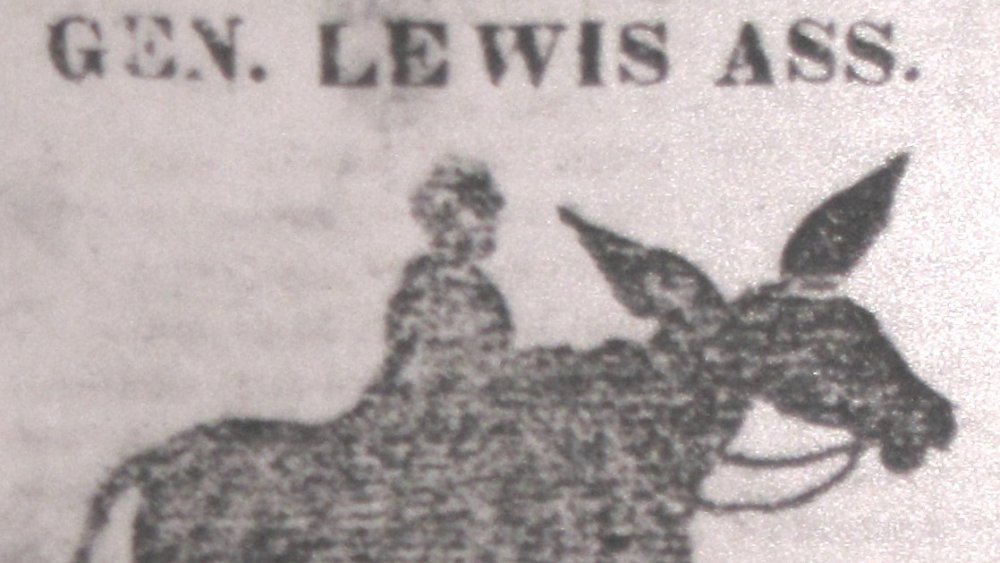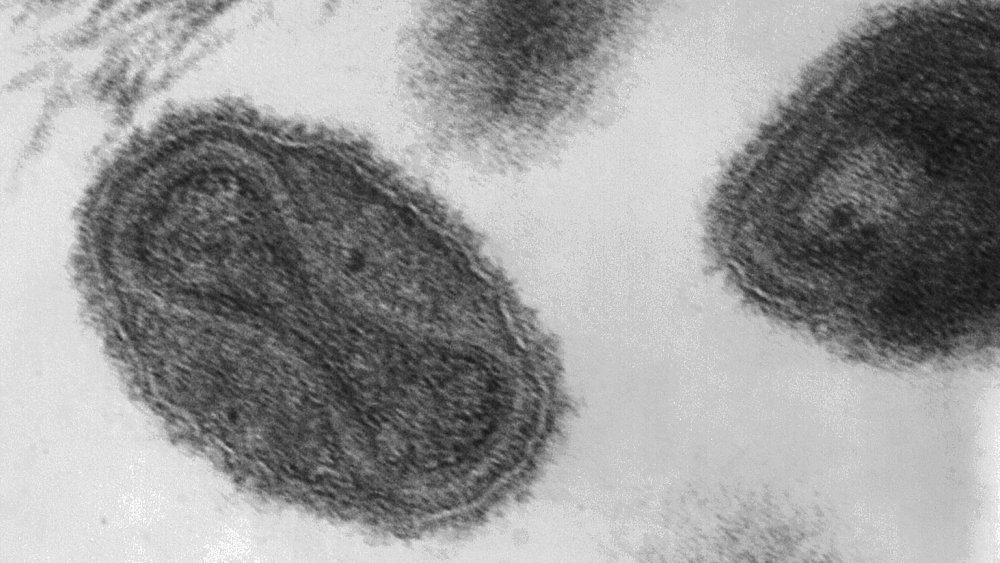The Messed Up History Of Smallpox
Most people nowadays don't have to know much about smallpox because they were born into a world where its dangers have been mitigated. Though it was once a disease with a mortality rate of around 30% that would leave many of its survivors blind, scientists and doctors rid the world of naturally occurring smallpox by the 1970s. And smallpox is only one of two diseases that humans have managed to eradicate, the other one being Rinderpest, a viral ailment that affects hoofed animals.
However, just because smallpox has been eradicated doesn't mean that its messy legacy has been remedied, and fears of smallpox recurring through artificial means continue to persist today. The history of smallpox is filled with horrors and pitfalls, and it's only by being aware of this history that we may avoid repeating it. Smallpox wasn't the first virus, and it won't be the last. This is the messed up history of smallpox.
A basic overview of smallpox
Smallpox was a disease caused by the variola virus and was differentiated by its various presentations: ordinary, modified, malignant, and hemorrhagic. According to National Geographic, smallpox got its name from the Latin "varius," meaning "spotted" or "speckled," emblematic of the pus-filled pimples that afflicted smallpox victims. Since syphilis also causes similar rashes and was also known as "variola" in 15th-century France, smallpox was distinguished by being referred to as "la petite vérole," which translates to "the small pox." Unfortunately, even if you survive smallpox, you'll most likely be stricken with sterility, blindness, or scars from the pimples (also known as pockmarks). On the plus side, you would be immune to recurrent smallpox infections.
Smallpox was transmitted through airborne saliva and person-to-person contact and had an incubation period of 7-17 days after exposure, so typically a person will only be infectious once a fever has already developed. As a result, smallpox would usually be transmissible once the person was already sick in bed, effectively slowing down transmission rates, but that didn't stop smallpox from claiming over 300 million victims in the 20th century alone.
Through a collaborative worldwide effort, smallpox was technically eradicated by the second half of the 20th century. According to the World Health Organization, the last case of naturally occurring smallpox was in 1977 in Somalia. Ever since then, the only cases of smallpox were due to a laboratory accident in England in 1978, which isn't really reassuring.
The murky origins of smallpox
Medical historians use written records to assist in identifying diseases, but smallpox has a very spotted history. According to Baylor University Medical Center Proceedings, some scientists believe smallpox originated in 10,000 BCE, but verifiable descriptions of smallpox only begin to appear in 1122 BCE in China. Others claim that the mummy of Egyptian pharaoh Ramses V, who died in the 1150s BCE, shows signs of smallpox pustules, while scientists who recently sequenced smallpox DNA from a 17th-century Lithuanian mummy contend that the smallpox virus emerged as recently as the 1500s.
There are suggestions that smallpox is discussed in the Sushruta Samhita, an ancient Sanskrit medical text thought to have originated in the first millennium BCE. However, anthropologists such as Ralph Nicholas argue that the disease mentioned, masurika, is discussed too trivially to be about a disease as fatal as smallpox. Either smallpox upped its severity, or the affliction referenced has been misidentified as smallpox.
There are no confirmed references to smallpox in Europe until the 500s CE, but many try attributing the various plagues in European history to smallpox. Smallpox is thought by some scholars and physicians to be the main culprit of the plague of Athens that decimated the city in 430 BCE, but bubonic plague, typhoid, typhus, and measles are all contenders, and there's little consensus. Since several diseases include symptoms of a rash and fever, it's difficult for historians to identify illnesses from the past solely through written descriptions.
Smallpox as bioterrorism
No matter where smallpox originated, soon it had spread across the Asian and European continents. According to Smallpox and Its Eradication, published by the WHO, during the medieval period, there were frequent epidemics of smallpox, brought on by the movement of the Crusades. But these epidemics were nothing compared to the ones that would decimate the American and African continents as a result of colonialism and enslavement.
In the 1500s, Spaniards brought smallpox with them in their colonization of Mexico, beginning what would become an avalanche of epidemics that would wipe out and depress the populations of the Aztecs, Inca, and Mapuche in South America, and the Mohawk, Iroquois, and Cherokee in North America, just to name a few. To the Native Americans, the Europeans seemed comparatively immune to the disease, since most of them would have recovered from childhood infections, while the indigenous populations of the Americas had no developed defenses.
This vulnerability was also weaponized by Europeans. In 1763, British Field Marshal Jeffrey Amherst advocated giving smallpox-infected blankets to indigenous Americans during Pontiac's War. Having seen how the devastating effects of smallpox on the indigenous populations in South America ensured the military success of the invaders, Amherst was quite amenable to the suggestion of using biological warfare in his own invasion. This notorious incident is known since it was documented by Amherst himself in his letters, but it's not unlikely that many others used similar methods.
The various variolations of smallpox
Variolation, also known as inoculation, was one of the processes through which people would acquire smallpox immunity. Per the US National Library of Medicine, the practice would involve infecting an individual with residue from a smallpox scab or pustule, resulting in a less severe outbreak to induce immunity, should the individual survive their encounter with smallpox. While this process wasn't risk-free and could even cause an epidemic on its own, the 1-2% mortality rate of variolation seemed preferable to the 30% mortality rate of naturally contracted smallpox.
There are accounts of variolation in China as early as the mid-1500s, where smallpox scabs and particles were blown up the nose to induce an infection. In India, there are also descriptions of an inoculation technique in the 16th century that mirrors vaccination today: A needle would be covered in fluid residue from smallpox pustules and then used to puncture the skin repeatedly.
As variolation spread to Britain and colonial America, its origins were attributed to the Ottomans, and it's possible that the Ottomans were the ones who originally spread the practice to India, since they used a similar method of puncturing the skin. But in the end, the origins of smallpox's inoculation are as murky as the origins of the virus itself.
The first smallpox vaccine and its mystery ingredients
The neat urban legend of Edward Jenner's genesis of the smallpox vaccine fits the typical framework of supposedly genius men. Having grown up in the English countryside, Jenner noticed that milkmaids weren't vulnerable to smallpox. Growing up and becoming a doctor, he put a theory to the test in 1796 and infected his gardener's son with pus from a cow's cowpox pustules. After six weeks, Jenner attempted to infect the child again with smallpox, and after the boy didn't fall ill, Jenner conceived of the first smallpox vaccine.
While Jenner was certainly not the first to suggest or experiment with infecting patients with cowpox, he was soon set down in history books as the father of immunology. But even the story of his original vaccine is suspect. In 2017, virologists analyzed an early vaccine from 1902 and found that the vaccine used a virus strain that is much closer to horsepox, publishing their results in The New England Journal of Medicine.
According to Popular Science, since the vaccinia virus, the virus used in the smallpox vaccine, isn't found in nature and doesn't quite resemble horsepox or cowpox or variola itself, there's added confusion as to what the original vaccine could have been made from. And since viruses change from host to host, and vaccines are created with the viruses at hand, it's unlikely that the ingredients of the original vaccine will ever be known.
Unethical vaccine trials of smallpox
If Jenner's experiment with the gardener's son didn't sound ethical, that's because it wasn't. While the practice of variolation had a long-standing history, as The Conversation notes, Jenner's actions raise concerns when it comes to performing experiments on the children of one's employees. It's difficult to say whether there was coercion at play, but it's safe to say that there are questions of consent.
And Jenner wasn't the first to unethically experiment with smallpox. Before him, in 1721, Sir Hans Sloane, who later went on to establish the British Museum, experimented on prisoners in what was called "The Royal Experiment." In his papers, he talks of trials on orphaned children as well. Prisoners were promised a pardon if they participated, which, to be fair, they were granted after their variolation. The experiment was done at the pressing of Lady Mary Wortley Montagu, a friend of Caroline, the Princess of Wales, and both were greatly concerned for the welfare of their own children.
According to Smithsonian Magazine, Thomas Jefferson also conducted his own vaccine trials after word of Jenner's success crossed the Atlantic, using the people he had enslaved as guinea pigs. Luckily, there were no casualties due to his experimentation, and while his trials helped spread the use of vaccination in the United States, it also set a horrific precedent for medical experimentation on black people in the country.
The empty act of 1813
In 1813, the United States government enacted the Vaccine Act of 1813, which was to ensure the creation of genuine vaccines, as well as their availability and distribution. It was an empty gesture, though — Congress repeatedly refused to allocate funding to the Act, which led to it being dreadfully ineffective.
Dr. James Smith was the immediate beneficiary of the Act, and suggestions that the Act would give Dr. Smith a monopoly on vaccines led to criticism and backlash against the law. Dr. Smith himself claimed that greedy physicians were the ones seeking to discredit him, since he removed them from the vaccination process by sending out vaccines to laypersons. Physicians were also used at the time to verify the authenticity of vaccines through their own examination or administration, and Dr. Smith frustrated this business as well by offering certificates of veracity based on people mailing in their own vaccine scabs. He also offered the vaccine free of charge, which he said equally enraged doctors looking to turn a profit.
However, after five years of repeatedly asking the government for money and having his requests denied, Dr. Smith decided that he had to forgo his dream of free and available vaccination and started charging $5 for a supply of vaccines. People resented having to pay for a vaccine, and Dr. Smith quickly had to turn to private donations, struggling to continue his work.
A deadly mistake and the smallpox Tarboro Tragedy
One of the provisions of the Vaccine Act mandated that a federal agent be in charge of distributing genuine vaccines, and Dr. Smith had been that federal agent. Since Congress had refused to provide him with any funding, he was one of few agents and had very few resources available to him. No one quite knows exactly what transpired in the events leading up to this tragic mistake, but this much is known: In November 1821, Dr. Smith mistakenly sent out glass slides with smallpox virus instead of cowpox, which resulted in an outbreak of smallpox in Tarboro, North Carolina. By the end, 60 people had become ill, and ten people had died.
Realizing his mistake and worrying that he might've made similar errors in other glass slides, Dr. Smith sent out a notice to physicians in January 1822, warning them that the previous vaccines may have been tainted, essentially an early example of a terrifying company recall. Some say this event led to the repeal of the Vaccine Act, though it might've just been a convenient scapegoat by long-standing critics of the Act. While a House oversight committee determined that Dr. Smith's actions were a tragic error and that the Vaccine Act was too beneficial to repeal or change, the damage had been done. In April and May of 1822, the House and Senate respectively voted to repeal the Vaccine Act, leaving no federal vaccination plan in its stead.
The colonial legacy of genocide
Through European invasion, smallpox had all but annihilated the indigenous populations across the continents, and later on, reparations were feigned. In 1832, the United States enacted the Indian Vaccination Act, which was theoretically meant to allocate funds toward the vaccinations of Native Americans.
However, people such as Secretary of War Lewis Cass were quick to assert that "no effort would be made ... under any circumstances ... to send a surgeon higher up the Missouri than the Mandans, and I think not higher than the Aricaras [sic]." Not only would this actively hinder the vaccine from reaching those who needed it most, but this refusal of action can be directly linked to the succeeding 1837 Great Plains smallpox epidemic.
According to Democracy and Me, in a report discussing the victims of the epidemic, the Commissioner of Indian Affairs stated that, "No attempt has been made to count the victims," though the numbers are sure to exceed 17,000. Governments have repeatedly shown flippancy toward their indigenous populations when it comes to the spread of disease, the legacy of which is not limited to smallpox.
Smallpox and the rise of anti-vaxxers
Anti-vaccination efforts existed almost from the moment vaccination efforts started, but in 1905, the Supreme Court case Jacobson v. Massachusetts upheld the right of states to enforce compulsory vaccination for smallpox. This was the spark that led to the full-fledged movement known as anti-vaccination, or anti-vaxxers. Three years later in Philadelphia, the Anti-Vaccination League of America was created in order to promote resistance against medical tyranny. While they were concerned about the risks associated with vaccines, a great deal of their rhetoric was centered on the anxiety of governmental intervention in the private sphere of health.
According to Crosscut, one of the most notorious anti-vaxxers was a progressive activist named Lora C. Little. Initially working in Oregon as an advocate against a state-sponsored sterilization law, she began to crusade around the Northwest, encouraging people to refuse the smallpox vaccine. She was arrested in 1918 after criticizing the US military and accused of inciting mutiny under the Espionage Act, but she was released after the charges were thrown out. She continued her proselytizing, leading the Propaganda Department of the American Medical Association to monitor her for the rest of her life.
The smallpox anti-vaxxers were subdued in 1922, when Zucht v. King determined that cities had a right to require a certificate of vaccination in order to attend school. The court upheld the precedent set by Jacobson and underscored the government's role in public health.
Accidental smallpox outbreaks
While naturally occurring outbreaks of smallpox decreased through the 20th century, there were a handful of incidents where controlled smallpox got loose. One example is in 1971, when there was an outbreak which originated from a biological testing facility called Aralsk-7 on Vozrozhdeniya Island, located in the Aral Sea in the Soviet Union. According to The New York Times, the outbreak was caused during a field testing of 400 grams of smallpox, which made its way onto a docked ship and traveled to Aralsk, a nearby city. While three people died out of the ten who fell ill, Moscow didn't even acknowledge the outbreak until 2001.
The last known casualty of smallpox also died as a result of an accidental exposure. Even though Time Magazine had declared smallpox eradicated in 1972, medical photographer Janet Parker become the disease's final victim in 1978. Parker worked at Birmingham Medical School, where Professor Henry Bedson ran a smallpox laboratory. When Parker fell ill, and tests revealed smallpox, Bedson knew that the virus must have originated in his laboratory. No one knows exactly how Parker got infected, although with her office located above the laboratory, there were speculations that it traveled through an air vent. Bedson killed himself shortly before Parker succumbed to the illness, leaving a note that read, "I am sorry to have misplaced the trust which so many of my friends and colleagues have placed in me and my work."
The debate on smallpox virus retention
Even though the smallpox virus has been eradicated and no longer occurs naturally in the world, there are ongoing debates about keeping forms of the virus. According to NPR, both Russia and the United States have repeatedly refused to destroy stockpiles of the virus, claiming that it's needed for research. Against this, physicians such as Dr. D.A. Henderson, who was part of the global effort to eradicate smallpox, says that the risks outweigh the rewards when it comes to keeping the virus, especially having seen the perils of accidental outbreaks.
These debates may soon become a moot point, since Canadian researchers demonstrated in 2016 that the virus could potentially be constructed with little biomedical expertise. According to Science Magazine, a group of virologists were able to synthesize horsepox using genetic pieces they were able to order through the mail. If it's possible with horsepox, then smallpox synthesization is probably not far off. This, however, brings up another debate about scientific regulation, which becomes a pretty hot topic when it involves extinct viruses that can be used as bioweaponry. For now, smallpox remains, as Richard Preston calls it, "the demon in the freezer."
